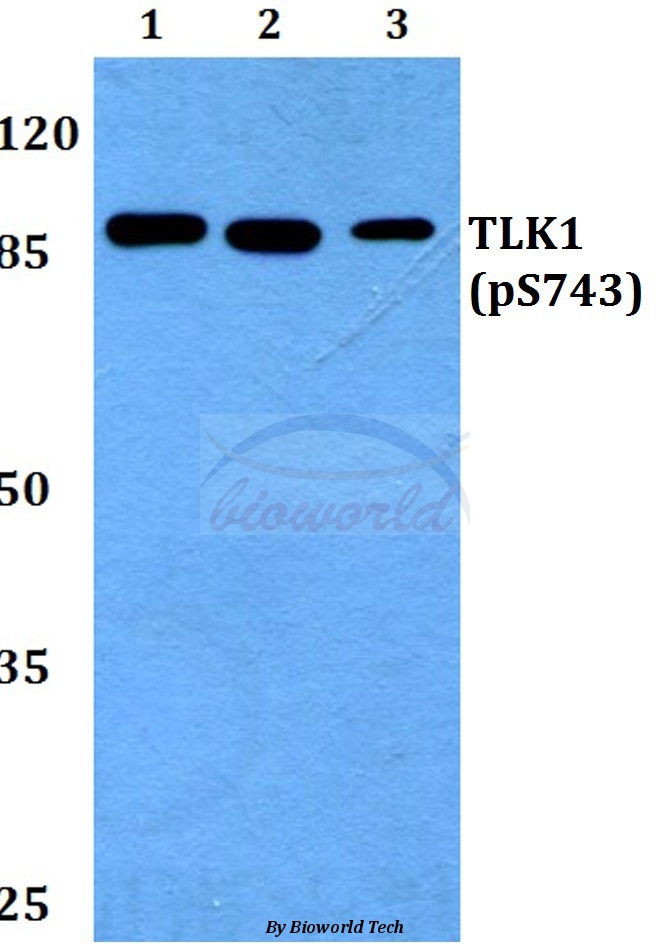Product Name :
TLK1 (phospho-S743) polyclonal antibody Background :
The Tousled-like kinases (TLK1 and TLK2, also designated PKU-β and PKU-α, respectively) are the human homologs of the Tousled gene from Arabidopsis thaliana, which encodes a Serine/Threonine kinase that is necessary for proper organ morphogenesis. Both TLKs contain a nuclear localization signal and a predicted coiled-coil region in the N-terminal domain. TLK is ubiquitously expressed, and is prevalent in mouse testis, especially in pachytene spermatocytes and round spermatids. It displays a propensity to dimerize through an interaction between its coiled-coil structure and is able to autophosphorylate, as well as phosphorylate exogenous substrates. TLK1 and TLK2 are regulated by the cell cycle, showing maximum activity during S phase. Subsequently, they are thought to regulate the development of multicellular organisms, including playing a key role in spermatogenesis, through a series of phosphorylations. Product :
Rabbit IgG, 1mg/ml in PBS with 0.02% sodium azide, 50% glycerol, pH7.2 Storage&Stability :
Store at 4°C short term. Aliquot and store at -20°C long term. Avoid freeze-thaw cycles. Specificity :
p-TLK1 (S743) polyclonal antibody detects endogenous levels of TLK1 protein only when phosphorylated at Ser743. Immunogen :
Synthetic phosphopeptide derived from human TLK1 around the phosphorylation site of Serine 743. Conjugate :
Unconjugated Modification :
Phosphorylation
TLK1 (phospho-S743) polyclonal antibody Background :
The Tousled-like kinases (TLK1 and TLK2, also designated PKU-β and PKU-α, respectively) are the human homologs of the Tousled gene from Arabidopsis thaliana, which encodes a Serine/Threonine kinase that is necessary for proper organ morphogenesis. Both TLKs contain a nuclear localization signal and a predicted coiled-coil region in the N-terminal domain. TLK is ubiquitously expressed, and is prevalent in mouse testis, especially in pachytene spermatocytes and round spermatids. It displays a propensity to dimerize through an interaction between its coiled-coil structure and is able to autophosphorylate, as well as phosphorylate exogenous substrates. TLK1 and TLK2 are regulated by the cell cycle, showing maximum activity during S phase. Subsequently, they are thought to regulate the development of multicellular organisms, including playing a key role in spermatogenesis, through a series of phosphorylations. Product :
Rabbit IgG, 1mg/ml in PBS with 0.02% sodium azide, 50% glycerol, pH7.2 Storage&Stability :
Store at 4°C short term. Aliquot and store at -20°C long term. Avoid freeze-thaw cycles. Specificity :
p-TLK1 (S743) polyclonal antibody detects endogenous levels of TLK1 protein only when phosphorylated at Ser743. Immunogen :
Synthetic phosphopeptide derived from human TLK1 around the phosphorylation site of Serine 743. Conjugate :
Unconjugated Modification :
Phosphorylation
-
 Western blot (WB) analysis of p-TLK1 (S743) polyclonal antibody at 1:500 dilution Lane1:MCF-7 whole cell lysate Lane2:Rat brain tissue lysate Lane3:H9C2 whole cell lysate
Western blot (WB) analysis of p-TLK1 (S743) polyclonal antibody at 1:500 dilution Lane1:MCF-7 whole cell lysate Lane2:Rat brain tissue lysate Lane3:H9C2 whole cell lysate
Bioworld Biotech only provide peptides for our antibodies and do not provide additional peptide customization services.
Price/Size :
USD 368/1mg/vial
Tips:
For phospho antibody, we provide phospho peptide(0.5mg) and non-phospho peptide(0.5mg).Describe :
Blocking peptides are peptides that bind specifically to the target antibody and block antibody binding. These peptide usually contains the epitope recognized by the antibody. Antibodies bound to the blocking peptide no longer bind to the epitope on the target protein. This mechanism is useful when non-specific binding is an issue, for example, in Western blotting (WB) and Immunohistochemistry (IHC). By comparing the staining from the blocked antibody versus the antibody alone, one can see which staining is specific; Specific binding will be absent from the western blot or IHC performed with the neutralized antibody.Formula:
Synthetic peptide was lyophilized with 100% acetonitrile and is supplied as a powder. Reconstitute with 0.1 ml DI water for a final concentration of 10 mg/ml.The purity is >90%,tested by HPLC and MS.
Storage:
The freeze-dried powder is more stable. For short time at 2-8°C. For long term storage store at -20°C.
Note :
This product is for research use only (RUO only). Not for use in diagnostic or therapeutic procedures.
 TLK1 (phospho-S743) polyclonal antibody
TLK1 (phospho-S743) polyclonal antibody  Datasheet
Datasheet COA
COA MSDS
MSDS SHIP
SHIP